Shōgun Drama Review

Shōgun Drama Review: “Shōgun: Winds of Change” thrusts viewers into the heart of 17th century Japan, a period of political turmoil and cultural rigidity. This captivating drama follows the extraordinary journey of John Blackthorne, a brash English navigator shipwrecked on the shores of this isolated nation. We delve into a world of clashing cultures, fierce samurai warriors, and the rise of a powerful Shōgun.

A Fish Out of Water: John Blackthorne’s Odyssey
John Blackthorne, played with compelling intensity by [Actor Name], embodies the “fish out of water” trope. Initially arrogant and ethnocentric, he struggles to adapt to the strict social hierarchy and complex customs of Japan. Blackthorne’s journey becomes one of cultural immersion and personal transformation. He learns the art of swordsmanship, navigates the intricacies of honor and duty within the samurai code, and even grapples with the beauty of Japanese culture.
A World in Flux: The Rise of a Shōgun
The series doesn’t solely focus on Blackthorne’s experience. It weaves a compelling narrative around the political landscape of Japan. We witness the power struggles between warring daimyos (feudal lords) and the rise of Lord Toranaga, a cunning and ambitious warrior on his path to becoming Shōgun. [Actor Name] delivers a nuanced performance, portraying Toranaga’s ruthlessness and strategic brilliance alongside his moments of vulnerability and self-doubt.
Beyond the Samurai Sword: Unveiling a Rich Culture
“Shōgun: Winds of Change” doesn’t shy away from showcasing the richness of Japanese culture. The series visually stuns with breathtaking landscapes, detailed sets that transport viewers to Edo period Japan, and meticulously designed costumes that reflect the social hierarchy. Additionally, the show incorporates elements of Japanese art, tea ceremonies, and traditional martial arts, offering viewers a glimpse into a fascinating historical period.
A Love Story Forged in Conflict
Amidst the political turmoil and cultural clashes, a forbidden romance blossoms between Blackthorne and [Character Name], a strong-willed woman trapped within the constraints of Japanese society. [Actress Name] portrays this character with grace and defiance, making their forbidden love story a compelling subplot that adds emotional depth to the narrative.
A Language Barrier, a Cultural Divide
The series effectively portrays the challenges of communication and cultural understanding. Blackthorne’s initial inability to speak Japanese creates tension and humorous situations. The show’s utilization of subtitles and the gradual introduction of Blackthorne learning the language add a layer of realism to his journey of integration.
Beyond Stereotypes: Exploring Complexities
“Shōgun: Winds of Change” avoids portraying Japanese characters as one-dimensional stereotypes. We encounter a diverse cast with varying motivations and personalities. From the stoic samurai warriors to the cunning court advisors, the show offers a nuanced look at Japanese society during this time period.
Historical Accuracy with Creative License
The series takes liberties with historical events, focusing on the fictional characters of Blackthorne and Toranaga. However, it maintains a sense of historical accuracy by depicting the social customs, political climate, and cultural practices of 17th century Japan. This blend of fictional narrative and historical context allows for an engaging and informative viewing experience.
A Show for History Buffs and Drama Fans Alike
“Shōgun: Winds of Change” caters to a broad audience. History buffs will appreciate the immersive portrayal of feudal Japan, while drama fans will find themselves captivated by the compelling characters, forbidden romance, and political intrigue.
Critical Reception and Potential Shortcomings
Despite its strengths, “Shōgun: Winds of Change” might face criticism for its pacing, which could be slow at times, particularly in the initial episodes where Blackthorne struggles to adapt. Additionally, the graphic violence might not be suitable for all viewers.
A Legacy of Cultural Exchange
“Shōgun: Winds of Change” offers a valuable lesson in cultural exchange and understanding. Through Blackthorne’s journey, viewers witness the beauty and complexity of Japanese customs while also recognizing the importance of respecting other cultures.
Building upon the groundwork laid in the previous section, let’s delve deeper into the captivating world of “Shōgun: Winds of Change.” Here, we’ll explore the show’s potential for character development, analyze the portrayal of gender roles in feudal Japan, and consider the series’ lasting impact on historical dramas.
Character Arcs: Growth and Transformation
“Shōgun: Winds of Change” has the potential for rich character development. John Blackthorne’s initial arrogance gives way to respect and even admiration for Japanese culture. The series could explore this transformation in greater depth, showcasing internal struggles and moments of self-reflection as Blackthorne grapples with his changing identity in a foreign land. Similarly, Lord Toranaga’s journey to becoming Shōgun could be further explored. The show could delve into his motivations, his relationship with advisors and rivals, and the moral compromises he makes on his path to power.
Women in a Warrior’s World: Challenging Traditions
The series offers an opportunity to explore the limitations placed on women in Japanese society during the feudal era. [Character Name]’s character, caught between her duty and her forbidden love for Blackthorne, presents a compelling starting point. The show could delve deeper into the lives of other female characters, showcasing the societal pressures they face and their quiet acts of defiance or resilience within a patriarchal system.
Balancing Action and Political Intrigue
While the series features thrilling sword fights and captivating battle sequences, it’s crucial to maintain a balance with political intrigue. The complex web of alliances, betrayals, and power struggles within the daimyo courts offer fertile ground for compelling narratives. Showcasing the strategic negotiations, backroom deals, and the ever-present threat of assassination attempts can add depth and nuance to the political landscape.
A Feast for the Senses: Visual Storytelling
“Shōgun: Winds of Change” excels in visual storytelling. The production design can be further enhanced by incorporating traditional Japanese art forms like woodblock prints (ukiyo-e) or ink wash paintings (sumi-e) as visual references. Additionally, the use of Japanese music and sound design can further immerse viewers in the historical period.
Beyond the Small Screen: Educational Impact
“Shōgun: Winds of Change” has the potential to spark educational interest in Japanese history and culture. The series can act as a springboard for viewers to delve deeper into the fascinating world of 17th century Japan. Educational institutions and streaming platforms could partner to create supplemental materials that explore the historical context, cultural practices, and prominent figures depicted in the show.
A Genre-Bending Triumph?
“Shōgun: Winds of Change” occupies a unique space within the historical drama genre. While it offers a glimpse into a specific period, the core themes of cultural exchange, forbidden love, and the pursuit of power resonate with audiences across cultures and time periods. This blend of historical accuracy, captivating characters, and timeless themes has the potential to elevate “Shōgun: Winds of Change” beyond a typical historical drama.
A Legacy of Cultural Appreciation
“Shōgun: Winds of Change” can leave a lasting impact on historical dramas. Its commitment to cultural sensitivity, its exploration of complex social dynamics, and its nuanced portrayal of historical figures can inspire future shows to approach historical narratives with depth and respect.
A World Waiting to be Explored: The Future of Shōgun
“Shōgun: Winds of Change” offers a captivating glimpse into a bygone era. The potential for further character development, deeper exploration of social issues, and a balanced portrayal of action and political intrigue paves the way for a successful and engaging series. Whether through additional seasons or spin-offs focusing on different characters or historical events, the world of “Shōgun: Winds of Change” offers fertile ground for captivating storytelling and a deeper understanding of Japanese history and culture.

Leave a Comment